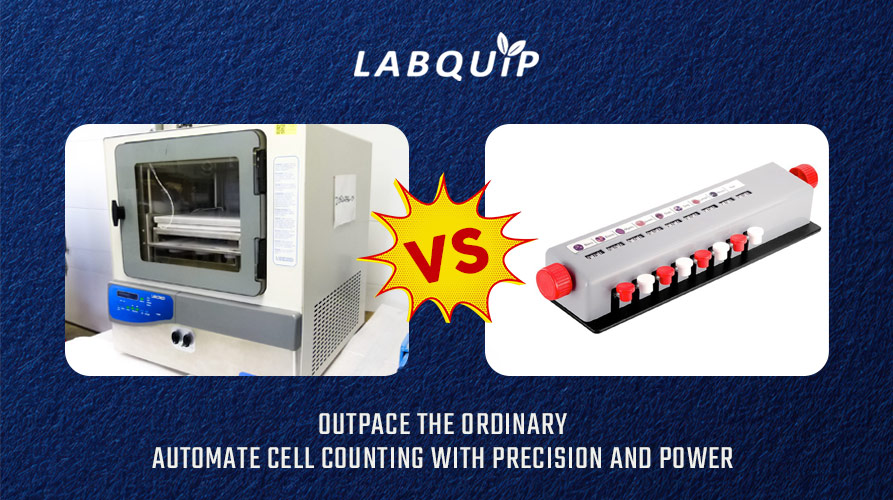Manual vs Automated Cell Counting: Why 2025 Belongs to Smart Labs
Cell Counter vs Manual Counting: Which One Wins in 2025?
Tired of squinting at a hemocytometer and second-guessing your cell counts?
You’re not alone. In 2025, labs are busier, faster and more data-driven than ever. So, it’s only natural to wonder: is manual counting still worth the time?
Whether you’re a researcher in a clinical lab or handling routine samples in a diagnostics setup and speed are everything. This is where Labquip Asia comes in — bringing next-gen cell counter laboratory solutions from global innovators, built to make your workflow smoother, smarter and way more efficient.
So, Let’s discuss: manual counting or cell counter — which one truly wins this year?
Manual Cell Counting: Tried, Tested, But Tiring
There’s no doubt manual counting has stood the test of time. It’s low-cost, straightforward and works well for students or small sample sizes. But if you’re running a busy lab, the cracks in this method begin to show.
✅ Pros:
- Cost-effective upfront
- No electricity of software needed
- Use for training or low-volume tasks
❌ Cons:
- Extremely time-consuming.
- Prone to human error and fatigue
- Inconsistent result between technician
- Limited throughput and scalability
If your lab handles more than a handful of samples daily, this method cloud be holding back your productivity.
⚙️ Automated Cell Counter: Smart, Speedy and Scalable
This is where Labquip Asia’s cell counter solutions truly shine. BY partnering with GS Biotech, Labquip Asia offers high-performance cell counter designed for reliability and ease of use — all without burning hours at the bench.
✅ Pros:
- Super-fast results — count thousands of cells in seconds
- High accuracy with consistent repeatability
- Easy-to-use touchscreen interface
- Advanced data storage and export features
- Saves hours of technician labour every week
❌ Cons:
- Higher initial investment
- Requires minor training and upkeep
But the return on investment?
Massive. Most labs see improved workflow and fewer errors within the first few months of switching.
📊 Real Labs. Real Impact.
In a pathology lab in Mumbai, switching to Labquip Asia’s cell counter from manual methods reduced processing time by over 65% — all while increasing accuracy and technician satisfaction.
Another research facility fewer reported fewer discrepancies in reports and more reliable data, thanks to the real-time analysis feature. Their Conclusion?
Automation isn’t a luxury anymore — it’s a lab necessity.
⏱️ Time Efficiency & ROI: What It Means for Your Lab
Time saved is data gained.
While manual counting may seem economical, hidden costs — like technician hours rework and errors — add up quickly.
Labquip Asia Understands this better than most. That’s why their solutions prioritize not just speed, but usability and long-term value. The result?
Less Stress, more increase result and higher productivity across the board.
🏁 The Verdict: In 2025, Automation Leads
If you’re still using manual methods in a high-throughput lab, it’s like using dial-up in the age of 5G.
Labquip Asia, with its strong industry presence and premium product line, is helping labs across India step into the future of cell counting. The better question isn’t if you should upgrade — it’s when.
With our Strong industry presence and premium product line, is helping increase the value of future of cell counting.
The better question isn’t if you should upgrade — it’s when.
🔍 FAQs
Q.1: Why choose Labquip Asia for automated cell counters?
A.1: Labquip Asia partners with global brands like GS Biotech to offer top-tier technology backed by expert support and fast response service.
Q.2: Are automated cell counter really more accurate?
A.2: Yes, they reduce human error significantly and provide consistent, repeatable results even at high throughput levels.
Q.3: Is Training Provided with Labquip Asia’s Products?
A.3: Absolutely. Labquip Asia ensures each client receives onboarding support and guidance for smooth integration into the lab workflow.
Q.4: Will automation fit into a small-to-medium lab?
A.4: Yes, many compact models are designed for small labs, offering high performance without taking up spaces.
Need help selecting the right cell counter?
Reach out to Labquip Asia — where innovation meets trust in every drop of science.




